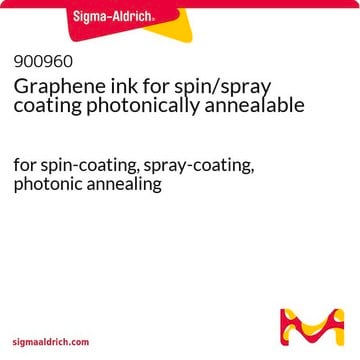739332
PEDOT:PSS
high-conductivity grade, 1.1% aqueous dispersion, surfactant-free
Synonym(s):
Orgacon™ ICP 1050, PEDOT:PSS, Poly(2,3-dihydrothieno-1,4-dioxin)-poly(styrenesulfonate)
About This Item
Recommended Products
product name
Poly(3,4-ethylenedioxythiophene)-poly(styrenesulfonate), 1.1% in H2O, surfactant-free, high-conductivity grade
grade
high-conductivity grade
form
liquid
greener alternative product characteristics
Design for Energy Efficiency
Learn more about the Principles of Green Chemistry.
sustainability
Greener Alternative Product
concentration
1.1% in H2O
resistance
<100 Ω/sq, <80% visible light transmission (40μm wet)
refractive index
n20/D 1.334
pH
<2.5
viscosity
30-100 cP(20 °C)
density
0.999 g/mL at 25 °C
greener alternative category
storage temp.
2-8°C
Looking for similar products? Visit Product Comparison Guide
Related Categories
General description
Application
Legal Information
Signal Word
Danger
Hazard Statements
Precautionary Statements
Hazard Classifications
Eye Dam. 1 - Skin Corr. 1B
Storage Class Code
8B - Non-combustible corrosive hazardous materials
WGK
WGK 3
Flash Point(F)
Not applicable
Flash Point(C)
Not applicable
Certificates of Analysis (COA)
Search for Certificates of Analysis (COA) by entering the products Lot/Batch Number. Lot and Batch Numbers can be found on a product’s label following the words ‘Lot’ or ‘Batch’.
Already Own This Product?
Find documentation for the products that you have recently purchased in the Document Library.
Customers Also Viewed
Articles
A detailed article on conducting polymer materials for flexible organic photovoltaics (OPVs) applications.
In the field of organic printable electronics, such as OLEDs and organic photovoltaics (OPVs), improved organic conducting and semiconducting materials are needed. The progress in two fields is reviewed in this article.
In the field of organic printable electronics, such as OLEDs and organic photovoltaics (OPVs), improved organic conducting and semiconducting materials are needed. The progress in two fields is reviewed in this article.
In the field of organic printable electronics, such as OLEDs and organic photovoltaics (OPVs), improved organic conducting and semiconducting materials are needed. The progress in two fields is reviewed in this article.
Our team of scientists has experience in all areas of research including Life Science, Material Science, Chemical Synthesis, Chromatography, Analytical and many others.
Contact Technical Service









